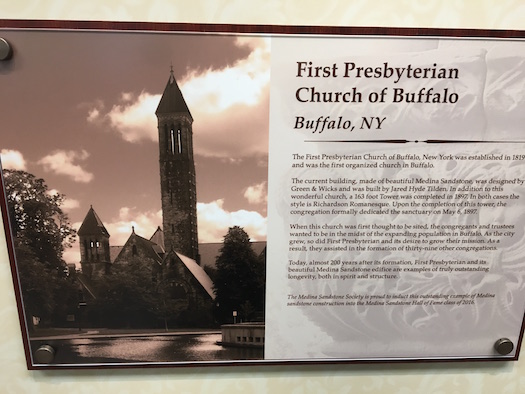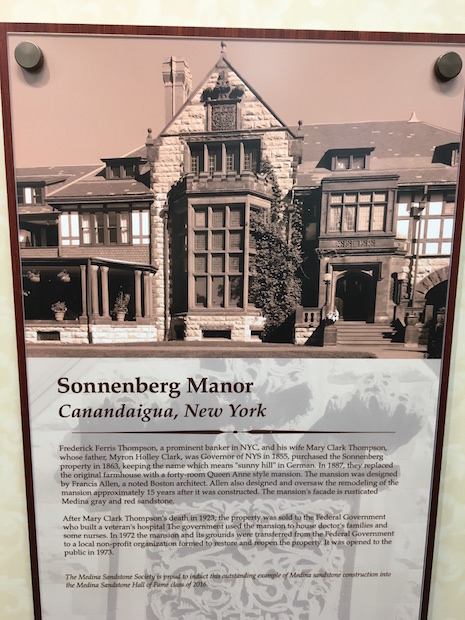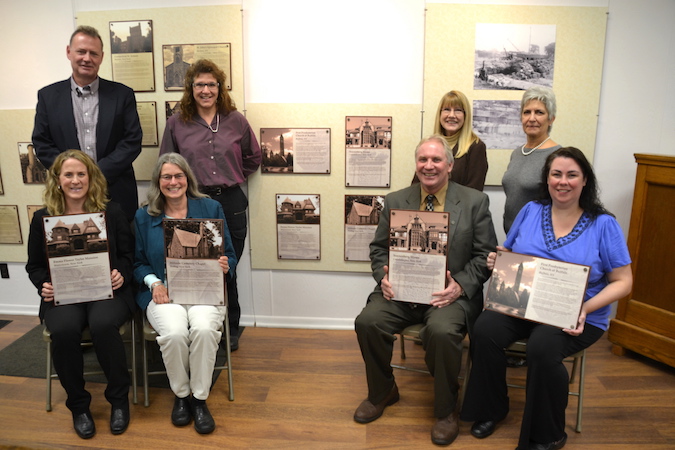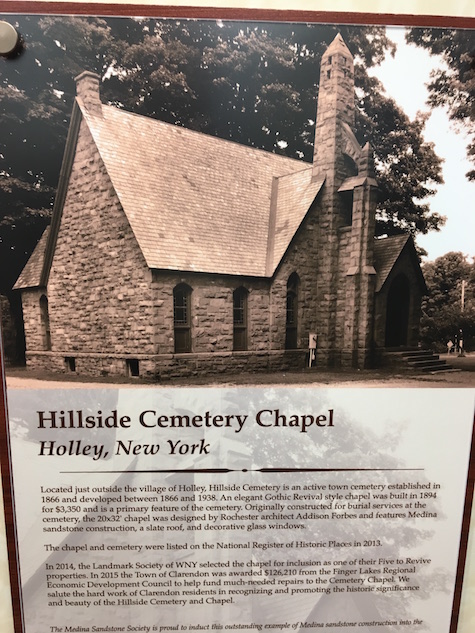4 sites added to Medina Sandstone Hall of Fame
2 mansions, a towering church, and a cemetery chapel all recognized
MEDINA – Four exceptional structures made of Medina sandstone were inducted today into the fourth class of the Hall of Fame for the Medina Sandstone Society, with two mansions, an enormous church and small cemetery chapel all recognized for their enduring significance to their communities.
The Medina Sandstone Society created the Hall of Fame in 2013 to recognize outstanding sites made of the local stone. The Hall of Fame is located inside Medina City Hall in the main meeting room. City Hall is a prominent Medina sandstone building on Main Street.
The initiative has proven an eye-opener for the Hall of Fame committee, which has travelled throughout Upstate New York, and even to Erie, Pa. to see some of the nominated sites.
“There are really some gorgeous, gorgeous buildings,” said Hall of Fame Committee member Jim Hancock during today’s induction ceremony.
He is on the committee with David Miller and Don Colquhoun. They travel together to visit the nominated sites. They look for architectural significance and uniqueness, overall beauty, longevity and maintenance.
The following were inducted in the Class of 2016 (Descriptions courtesy of Medina Sandstone Society) :
• Hillside Cemetery Chapel in Clarendon
Located just outside the village of Holley, Hillside Cemetery is an active town cemetery established in 1866 and developed between 1866 and 1938 at 4065 Holley-Byron Rd. An elegant Gothic Revival style chapel was built in 1894 for $3,350 and is a primary feature of the cemetery.
Originally constructed for burial services at the cemetery, the 20-by-32-foot chapel was designed by Rochester architect Addison Forbes and features Medina sandstone construction, a slate roof, and decorative glass windows. The chapel and cemetery was listed on the National Register of Historic Places in 2013.
In 2014 the Landmark Society of WNY selected the chapel for inclusion as one of their Five to Revive properties. In 2015 the Town of Clarendon was awarded $126,210 from the Finger Lakes Regional Economic Development Council to help fund much-needed repairs to the cemetery chapel.
The Clarendon Historical Society was praised for pushing to raise awareness of the chapel and secure the funding for repairs. Erin Anheier, one of the Historical Society members, said the grant documents were signed today and she expects much of the work to happen next year.
She is hopeful the chapel will be used for community events, including art shows, musical events and even small weddings.
“They’ve brought the chapel back to life,” said HOF Committee member David Miller.
Anheier thanked town officials, and local residents for supporting the efforts to save the chapel.
• Emma Flower Taylor mansion in Watertown

It is a massive 2 ½ story mansion constructed of rock faced, random course Medina sandstone. The home was designed by Charles Rich of the NYC firm of Rich Lamb, which also designed Sagamore, the home of Theodore Roosevelt on Oyster Bay, Long Island.
It has many distinguishing features including a porte-cochere, tiled roofs, a wrap-around porch on the first floor, second floor porches, rounded corner turrets, large overhanging gables, an asymmetrical footprint and surfaces, and widow bays. Its most unique feature is the use of Medina sandstone which was quarried in Medina, moved to the site by rail, and cut on site.
The mansion was converted to eight apartments in 1940 after Mrs. Taylor’s death. The Sandstone Society said it is a magnificent structure which was built and maintained in the classic Victorian tradition both externally and internally. The present owners, Richard and Katherine Pyne, have stayed true to preserving this architectural gem in its original Queen Anne style. The Pynes have owned the mansion for 13 years. It was listed on the National Register of Historic Places in 2002.
“This is a labor of love owning these structures,” Mrs. Pyne said. “We look after it with love year after year.”
• First Presbyterian Church in Buffalo

When this church was first thought to be sited, the congregants and trustees wanted to be in the midst of the expanding population in Buffalo. As the city grew, so did First Presbyterian and its desire to grow their mission. As a result, they assisted in the formation of thirty-nine other congregations.
Today, almost 200 years after its formation, First Presbyterian and its beautiful sandstone edifice are examples of truly outstanding longevity, both in spirit and structure, HOF member Jim Hancock said.
The church is located at 1 Symphony Circle across from Kleinhans Music Hall. Houghton College uses the church for classes. The Village Church also has services at First Presbyterian.
Elena Delgado, the church’s pastor, said First Presbyterian is challenged to maintain “the brick and mortar” of the property due to a declining membership and aging congregation. The church has welcomed the other organizations to use the site.
“It’s an extraordinary jewel of architecture,” she said. “It’s very majestic and it means so much to the community.”
• Sonnenberg Manor in Canandaigua

In 1887, they replaced the original farmhouse with a 40-room Queen Anne style mansion at 151 Charlotte St. The mansion was designed by Francis Allen, a noted Boston architect. Allen also designed and oversaw the remodeling of the mansion approximately 15 years after it was constructed.
The mansion’s facade is rusticated Medina gray and red sandstone. After Mary Clark Thompson’s death in 1923, the property was sold to the Federal Government who built a veteran’s hospital The government used the mansion to house doctor’s families and some nurses. In 1972 the mansion and its grounds were transferred from the Federal Government to a local non-profit organization formed to restore and reopen the property. It was opened to the public and listed on the National Register of Historic Places in 1973. The property is now under the New York State Parks System.
“Not only is the building magnificent, but the grounds and the gardens are as well,” said Hancock, the HOF committee member. “You have to go visit.”
David Hutchins has been the site’s executive director for 11 years.
“It’s an incredible place,” he said. “I’m honored to be there and proud to be part of its legacy of preservation.”
For more on the Hall of Fame, click here.







































































